Copyright 2020 - 2021 irantour.tours all right reserved
Designed by Behsazanhost
Persepolis Apadana Palace
Apadana
The largest and most prominent of all Persepolis palaces, the Apadana was a place where the nobility, emissaries, and gift-bearers from all parts of the Achaemenid Empire were gathered in the presence of the mighty one who designated himself King of Kings. The structure was commenced at Darius's order in 515 B.C. and was brought to perfection during Xerxes's rule. Its construction probably took some thirty years, as evidenced by glazed bricks inscribed with the name of Xerxes and found during the excavations. The palace remained in use for almost two centuries.
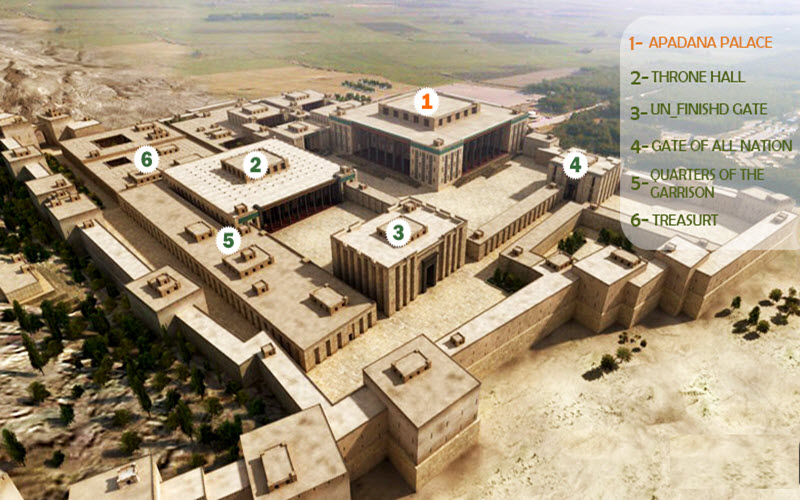 |
Apadana
The largest and most prominent of all Persepolis palaces, the Apadana was a place where the nobility, emissaries, and gift-bearers from all parts of the Achaemenid Empire were gathered in the presence of the mighty one who designated himself King of Kings. The structure was commenced at Darius's order in 515 B.C. and was brought to perfection during Xerxes's rule. Its construction probably took some thirty years, as evidenced by glazed bricks inscribed with the name of Xerxes and found during the excavations. The palace remained in use for almost two centuries.
The name Apadana (“the Audience Palace") is not found as the appellation of the building in any existing inscription. The correct name of the palace may have been the Hall of Columns, the title which appears on two tablets assigned to the reign of Darius, and found in the Treasury. It is assumed that the structure's immediate prototype was the Apadana in Susa. The Apadana of Persepolis stands on a socle about 3 m above the platform level and soars about 20 m high, dominating the entire complex. Most of this majestic edifice has disappeared, but a visitor with imagination may picture how magnificent the structure must have been in its heyday.
The Apadana consists of an immense central hall, surrounded by wide, open porticos on its north, east, and west sides, and a series of interconnecting, auxiliary rooms on the south. The building had seventy-two columns, of which only fourteen have survived. Of these, one, in the northeast corner of the east portico, has been restored. In the four corners of the building were the watchtowers, built around a staircase leading to the roof.
Beneath the base courses of the walls, in the northeast and southeast corners, archaeologists have unearthed two stone boxes (two others in the northwest and southwest corners have been pilfered). Each box contained gold and silver foundation tablets with a trilingual inscription dictated by Darius. The plates are now kept in the National Museum in Tehran.
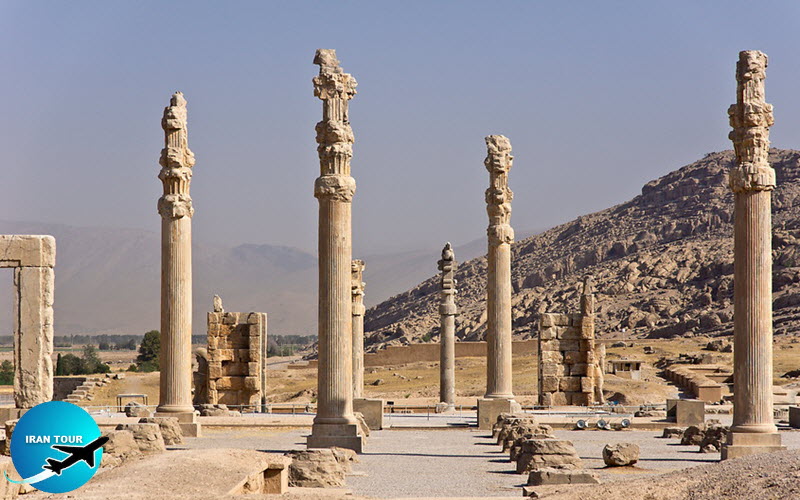 |
During the Achaemenid era, most guests went the long way around and entered the Apadana from the east. Today, most visitors take the shortest way, and approach through the south door of the Gate of All Lands, at the north side of the palace. They cross an L-shaped courtyard that stretches 167 m along the building's east side and 152 m along its north side. On the east side, the courtyard is 34 m wide, while on the north side it broadens to a width of about 50 m. The north section of the courtyard is bordered by the north staircase of the Apadana on one side, and the Gate of All Lands and the military barracks on the other.
North portico and staircase: The north portico of the Apadana is 60 m long and 25 m wide. Access to the north and east porticos is gained by four flights of steps, two of which, projecting from the platform, converge on a landing in its center; the remaining two ascend the platform from either extremity. The object of these stairways was to admit the free coming and going of the vast crowds that thronged here to pay homage to the king, and one must admire the ingenuity and practical wisdom of the architect The stairways are entirely covered with magnificent bas-reliefs. The carvings on the north staircase are rather badly damaged since throughout the centuries they have remained exposed to the elements, as well as to the hostile hands of treasure seekers and iconoclastic Muslims. In contrast, the bas-reliefs of the east stairway are much better preserved, mainly because these stairs were entirely covered by ashes and debris until their excavation in 1932.
The front wall of the projecting central landing of the north stairway shows two face-to-face groups of military men, with four men in each group. They stand on either side of an unengraved panel, perhaps intended for a royal inscription that was never carved. Originally the central panel featured the scene of a royal audience, but
this was dismantled and transferred to the Treasury. The upper register, carved on a separate stone, is gone, but it may have shown the farr, hovering above the soldiers and flanked by two sphinxes with lion bodies, eagle wings, and crowned human heads; these sphinxes raise a foreleg in a gesture of respect before the winged figure. The triangular side panels of the stairway's front section show a lion devouring a bull, framed by rows of date palms and cypresses.
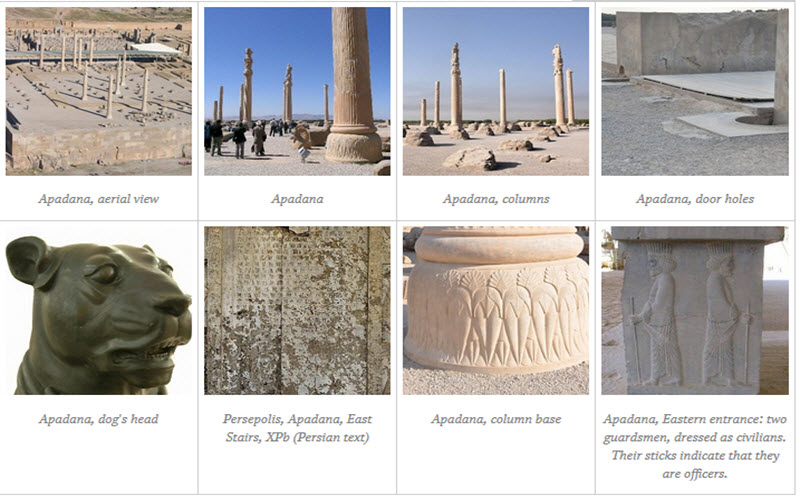 |
The left side of the north stairs' rear facade portrays the Immortals (the king's famous guards, so-called because their number of ten thousand was never permitted to diminish - each man dying in combat was immediately replaced by another soldier) together with Persian and Median nobles. The right side shows twenty-three groups of gift-bearing subject nations of the Achaemenid domain. On the east staircase the arrangement is reversed, so that one can imagine the full panorama of the figures by matching their representations on both staircases. At either end of the north, a staircase is a repetition of the combat between the lion and the bull. To the right of this scene on the west is a trilingual cuneiform inscription by Xerxes, stating that all he had built here and elsewhere was owing to the favor of Ahuramazda. The symmetrical panel on the east has been left blank.
 |
The inner surfaces of the stairs are bordered at ground level by a continuous bas-relief showing Achaemenid soldiers. The parapets of the north stairways were crowned by four-stepped battlements, today broken, and similar battlements are used in the same way throughout the terrace. The ceiling of the north portico was supported by two rows of six columns, about 20 m tall. Of these, today only one column remains standing Wooden doors, reaching the height of 15 m and encased in metal, with silver and gold inlay, led to the central hall. In front of the doorjambs at ground level are stones decorated with twelve-petaled rosettes. These stones have hemispherical depressions that served as sockets to hold the circular wood posts, by means of which the double-leaved palace doors pivoted, rather than using hinges. The walls separating the portico from the hall were 5.3 m wide and were built, as in other palaces in Persepolis, of mud-brick. The walls have long since vanished, but their foundation can still be seen.
Central hall:
Having inspected the north portico of the Apadana, visitors proceed to the central hall. It is here that the king appeared in front of his subjects, and the ceremony of presenting gifts was conducted. A square more than 60 m long on a side, this hall could accommodate about ten thousand people at a time. It contained thirty-six slender columns, soaring 20 m high - about the height of a modern five-story apartment house. The columns of the central hall stood on bases consisting of two square blocks placed one on top of the other, instead of on bell-shaped plinths. Marks on the floor show where the bases of the central hall's columns once stood: only three of these columns are still standing to almost their full height. The wall surfaces and the floor of the palace were coated with plaster and painted greenish-gray. The dados and the grids of the root beams were more extensively decorated with painted and carved were white green, and blue hangings, fastened with cords of fine linen and purple to silver rings and pillars of marble. The ceiling was made of the finest cedarwood, and to protect it from rain, brick gutters were hidden in the walls. This drained rainwater off to the underground sewage canals - a testimony to the remarkable efforts Achaemenid architects made to ensure the long life of their creation. The royal throne was situated in the central aisle of the hall, closer to the back wall, the exterior of which faced the private palaces. This may have been a deliberate safety measure for the ruler, as it gave him some respite from the scrutiny of masses of people.
West portico:
A single doorway led from the central hall to the west portico. Five of its original twelve columns are still standing. Their bases, unlike those of the central hall, are bell-shaped. According to some recent speculation, there may have been a break in the enclosing wall along the edge of the platform at this section, so that the ruler could enjoy the view of the surroundings, while the people gathering down on the plain could see the great building in its full effect.
South rooms:
The south section of the Apadana matched in size the porticos on the other three sides of the central hall. It was subdivided into a maze-like series of rooms, most likely allocated for service functions during the ceremonies. Two doorways from this wing gave onto the central hall. Via an array of elongated vestibules and corridors, the south section was connected to the so-called Royal Porch, which linked together with the main palaces of the complex. The Royal Porch had thirteen columns 5 m high, miniature copies of the columns of the north portico.
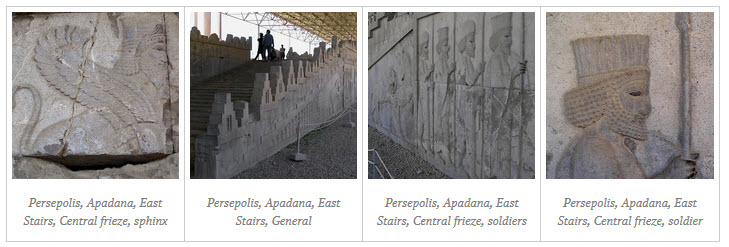 |
East portico:
The east portico is the most impressive feature of the Apadana, due to the outstanding bas-reliefs decorating the facades of its stairway. Like the north and west terraces, the east portico measures 60 m long and 25 m wide and features twelve columns organized in two rows. The columns are similar in shape to those of the north portico, but have double-headed lion capitals instead of double-headed bulls, and are generally more elegantly carved. The large statue of a double-headed lion now lying on the floor of the east portico once sat on top of one of the columns here. It was taken down for repairs but was never put up again. One can actually see a crack running right across the center of its body, and mended with iron clamps. The flat portion of the statue between the two lion heads gives an idea of the overall dimensions of the wooden beams - roof supports - which rested on this statue and extended to the statue on top of the next column.
East staircase:
The east stairway is the latest addition to the Apadana, and its bas-reliefs, executed after 486 B.C., reflect a considerable refinement over their northern predecessors. Although the decorations on the north and east stairways were intended to be mirror images of each other, there are slight differences in some of the details and in the style of the execution. Like anywhere, the stairway is made up of two parts, one in the back, attached to the building, and another in the front. Each has, at either end, thirty-one steps leading down to the courtyard below.
Central section:
Like the north stairs, the projecting part of the central staircase contains alternating figures of Persian and Median guards, standing in two groups opposite each other. The Persians carry a long spear and an oval shield, while the Medes I have a spear and a short dagger fastened to the right of the belt. This panel has replaced the original, royal audience scene. The earlier scene showed Xerxes and his son Darius, who was assassinated by another son, who then succeeded Xerxes as Artaxerxes I. Some think Artaxerxes I did not want to look at the image of the brother he had murdered, and so ordered the reliefs to be removed to the Treasury. Others hypothesize that the two noblemen portrayed in the scene are traitors who assassinated Xerxes and accused a crown prince of murdering his father, thus provoking Darius's death at the hands of his brother, Artaxerxes I.
Later, when Artaxerxes uncovered the plot, he had the conspirators executed, and so quite naturally, could not keep their portraits on the royal stairs. Because it depicted Artaxerxes's father and brother, the carving could not be destroyed; therefore, the best solution was for it to be relocated to another place in this case, the Treasury. Floating above the guards is a Farr flanked by two sphinxes. The lateral triangles show a lion devouring a bull. The lion is depicted full-face, a unique feature in Achaemenid sculpture, where the figures are almost always shown in profile.
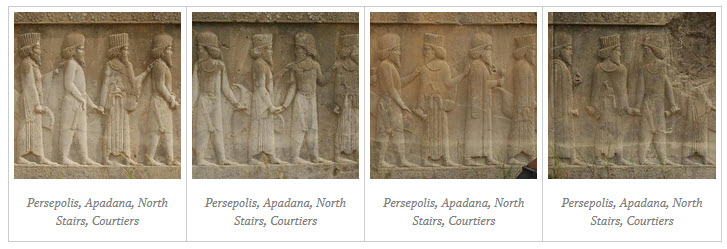 |
North section:
The northern panel shows three rows of Achaemenid nobles and military men, organized in three registers by bands of twelve petaled rosettes. The cuneiform inscription by Xerxes informs us that he completed the palace begun by his father and that he asked God to protect it. The scene of the lion and the bull, together with the groves of cypresses and palm trees add the final touch to the right wing of the staircase. Soldiers with long lances are portrayed at the front of each register. They are the Immortals, the famed guards of the king. They wear Persian garb, but instead of fluted hats, have twisted fillets around their heads.
The lower panels of the staircase portray soldiers of the ordinary regiments. They wear Persian dress, complemented by fluted, cylindrical hats. Each soldier, shown in profile with one foot in front of the other, is equipped with a quiver and spear, the pommel of which rests upon the toes of the forward foot. The group on the inner side of the central panel shows the similarity-looking military men, only this time carrying oval shields instead of quivers. These figures were possibly carved by small teams of artisans working under a master craftsman. Apparently
these artisans specialized in specific parts of a figure such as a face or a spear, which they would carve on a series of soldiers. This explains the obvious uniformity of the reliefs. The two lower tiers show regularly alternating Persian and Median dignitaries. Their number in each row is thirty-two, which corresponds exactly to the number of nations that Xerxes (in his Daiva inscription) claims as included in his empire. This would mean that a pair of officials accompanied each of the subject people at the festival. The nobles are relaxed and casual as they ascend the stairs.
Many of them carry flower buds (flowers were an important attribute, worn for their scent much as we wear perfume today), while others bring apples, quinces, and what may be colored eggs. The upper tier depicts behind the Immortals the king's valets, accompanied by a Median official. The valets carry whips, horse caparisons, and a royal footstool. They are followed by the Median chief of the stables, heading a procession of splendidly bedecked royal horses, each one led by a groom. A Persian attendant, perhaps the chief of the charioteers, brings up the rear of the parade. The chariots have wheels with twelve spokes, symbolizing the twelve months of the year. The axles have artfully carved pins, in whose decorations some have thought to distinguish a female figure. Badly damaged, the figure is practically
indiscernible, but if it is indeed a woman, it is a surprising representation of the female gender in this resolutely masculine panorama. The scene most probably shows an actual ceremony. The guards were positioned along the stairs, while attendants ushered the highest officials, foreign dignitaries, and gift-bearers into the royal presence.
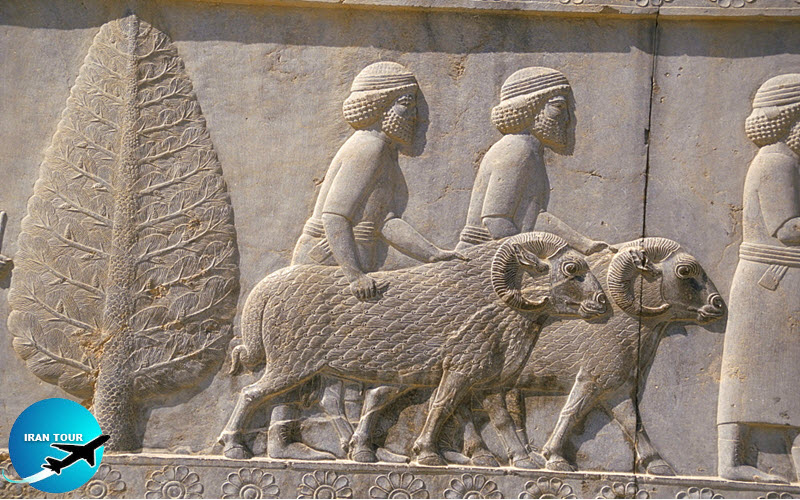 |
South section:
Perhaps the most interesting carving in Persepolis, it shows twenty-three delegations of Achaemenid subject nations, varying in number from three to nine men. The groups are distributed in three registers, separated by bands of twelve-petaled rosettes, with each group separated from the other by a cypress tree. The horizontal registers, together with the trees, form a grid into which the delegations are elaborately fitted. There is no precedent in the Near East for such a plan of vertical and horizontal composition. It seems likely that the outlines of each delegation were painted in some detail before the process of carving began, resulting in fine reliefs. It is even conceivable that the painting was more than a guide for the sculptors, being used to give an impression of the finished decoration long before the actual sculpture was done. This would explain the frequency of unfinished parts, which might have been overlooked as long as they were covered with paint, but are very striking today in contrast with the finished parts.
Every group is ushered by either a Persian or Median official, who leads by the hand of the first man in the group, perhaps the chief personage. The ushers wear torques, a sign of their prominent position, and hold short staffs as badges of office. Eighteen of the groups cover the facade, and five appear in diminished size on the inclined side of the stairway. The identification of the lands from which the delegations came derives from the details of their costumes and physical characteristics, their positions within the profession, and the nature of the gifts they bear. In many cases, the clues for identification are supplied by Herodotus's History, hieroglyphic inscriptions on the socle of the statue of Darius, and the Achaemenid carvings in Naqsh-e Rostam and Bistun, which list the lands of the empire and portray similarly clad figures accompanied by inscriptions.
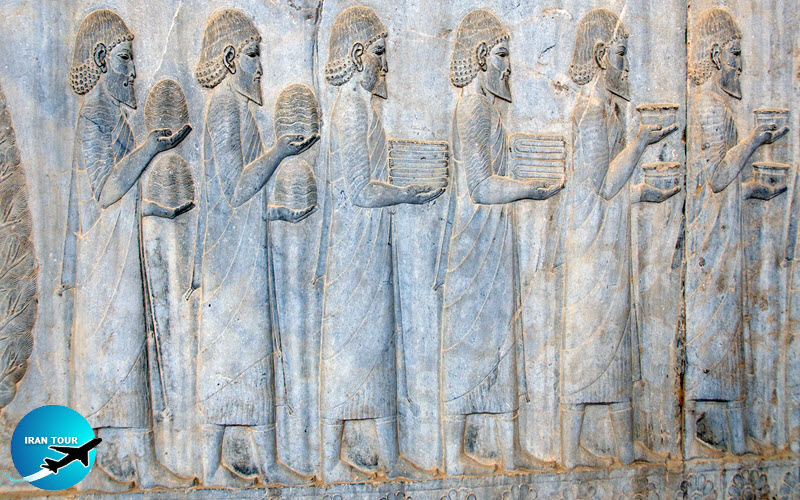 |
The arrangement of the groups seems unrelated to the way in which the lands of the empire are listed elsewhere. Although there is undoubtedly some protocol that determines the sequence, it has not been established. Perhaps the delegations were received in accordance with the distance of their country from the center of the Achaemenid Empire, starting with the closest neighbors, the Medes, and ending with the farthest satrapy, the Ethiopians. The offerings brought by the delegations are not taxes, as has long been presumed but presents for the king, given as we would give presents at Christmastime. Twenty-one of the delegations offer animals, of which horses, camels, and cattle appear most frequently. The delegations seem calm and happy, coming as free and invited guests rather than brought as slaves and forced into prostration in front of the royal throne.
Some sections of the carvings are artistically more advanced than others, while some are not polished or even completed. Panel 6, portraying the Lydians with two magnificently modeled horses and precious objects, and panel 8, showing the Assyrians bringing two rams, are often believed to exemplify the finest artistry. From right to left, the delegations are as follows: The Medes are the largest group, consisting of nine men. They wear tight trousers, long-sleeved coats, and some type of fabric head-covering. The coats reach to slightly above the knees and are laid over the shoulders like a cloak. The Medes are unarmed, except for their leader, who has a short sword fastened to his belt. He sports a bulbous hat with a short, tail-like appendage. The men carry a pitcher, two bowls, a short sword, two large circles, two large oblong rings (perhaps metal ingots), and folded clothes (overcoat, coat, and trousers).
The Elamites (Susians) comprise a group of six. They are clad in long robes falling in free folds the dress adopted by the Persians - and they have fillets around their hair. They bring two bounding in ducks' heads, two daggers in sheathes, and a leashed lioness with her two cubs. The Armenians are represented by three men in Median clothes, but the lower portion of their head covering is pulled back and tied behind the head in a style unlike that of the Medes. The Armenians bring a bridled stallion and a large vessel with griffin handles. There are some differences between the Armenians shown on the north and east stairways. The Aryans are represented by four men. They wear knee-long tunics fastened with a belt and a headdress, looking like a large scarf wrapped around their head, neck, and chin. They bring two bowls and a double-humped Bactrian camel, along with the skin of some large member of the cat family, 6 The Babylonians are a six-member delegation. They wear long tunics, folded cloaks, heeless shoes, and bell-shaped caps with long, hanging tips. They bring four shallow bowls; a piece of fabric with the netted and tasseled edge, perhaps of the type used as a canopy over the king's throne; and a humped bull. 6 The Lydians are also a group of six. They are distinguished by long, short-sleeved gowns and scarves with tasseled corners that drape over their left shoulders. They have low boots with slightly upturned toes - a type of footwear which for ages remained fashionable in Asia Minor. Four of the Lydian representatives wear very distinctively, tall, turban-like headdresses. The Lydians offer two beautiful vases with handles in the form of winged bulls, two plain metal bowls, two ringlets with griffin proteomes, and a chariot driven by two miniature horses. The bracelets and the vases correspond to extant metal objects from this country, which housed some of the ablest craftsmen of the Persian satrapies. The Arachosians are represented by four men. They look very much like Aryans, except for their head coverings and pantaloons, and they bring similar gifts. They bring two bowls, a double-humped Bactrian camel, and feline skin. 6 The Assyrians are represented by seven men wearing long, heavy gowns with short sleeves, fastened on the waist with a narrow girdle, skullcaps or wide fillets, and oddly modern-looking boots that lace up, and whose laces are tied in a bow. The Assyrians' presents consist of four metal bowls, two dressed animal skins, a scarf with tassels at the corners, and a pair of rams.
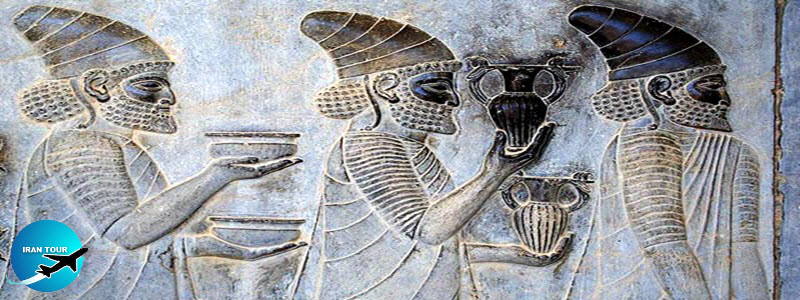 |
The Cappadocians are five men in Median clothes complemented with a short cloak. This cloak is fastened over the shoulder with a distinctive pin shaped like a bent arm with clutching fingers. Their gifts include a large stallion and a folded set of Median clothes consisting of a coat, an overcoat, and trousers with feet attached. 0 The Egyptians have for the most part disappeared through erosion, but their yet-visible hemlines make it obvious that they were six. Enough of their gifts can still be seen to determine that they brought, probably among other things, a bull and a folded piece of fabric. The Scythians are represented by six men in Median clothes and tall, pointed caps. All of them are armed with short, Median swords fastened insheathes at their belts, and their leader also carries a bow. Although it was obligatory to hand in weaponry before meeting the king, the Scythians seem to have enjoyed the pleasure of following their own rules. This may demonstrate the flexibility of the procedures in the Achaemenid court, as well as the king's respect for the militant character of this nation. The Scythians bring a bridled stallion; two decorated, golden circlets; and folded clothing. 12 The Ionians constitute a group of eight, wearing long, straight shirts and cloaks draped over the shoulder. Their gifts are composed of two ribbed cups, four shallow bowls, two sets of folded fabrics, and what looks like two pairs of convex cones of unknown nature -perhaps skeins of colored wool.
The Parthians are a group of four, in Median clothes and hairnets. Their elevated rank is evidenced by their fairly long beards. They offer two deep, and two shallow bowls and a double-humped camel. 4 The Gandarians are six men in knee-long shirts, straight mantles with high side slits, and hair fillets. They bring lances, a circular shield, and a humped bull. The Bactrians are four men in knee-long robes fastened with a belt and baggy pantaloons. gifts as brought by their northwestern neighbors, the Parthians: a pair of deep bowls and a pair of shallow ones, and a double-humped camel.
The Sagartians are represented by five men in clothes similar to those worn by the Median delegation, and they bring a folded set of Median clothes and a horse.
The Sogdians constitute a group of five in very characteristic long-sleeved jackets with an edge-cut aslant. Their hats have a pointed ear flap. All the Sogdians are armed with large bows. They bring a short sword, a pair of oblong circles, two short battle axes, and a bridled horse. 8 The Indians are represented by five men. Their leader wears sandals and a draped garment which leaves one arm and shoulder uncovered, while the rest of the group are barefoot and wear only the dhoti. They bring two pairs of jars (perhaps with spices or incense) in wicker baskets on a carrying stick, a pair of battle axes, and a jackass. The Skudrians are four men in knee-long shirts and cloaks, and a distinctive kind of headdress with earflaps | fastened under the chin.
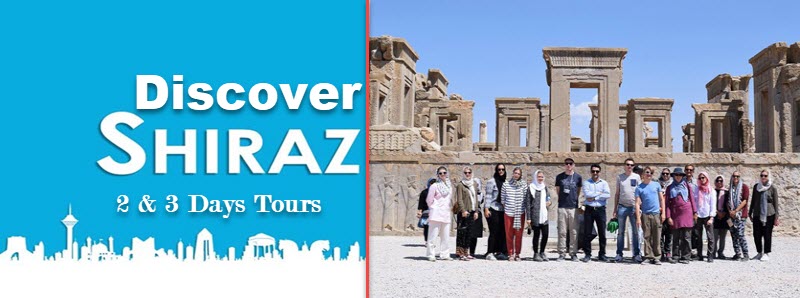 |
Their gifts include two pairs of lances, two shields, and a horse. The Arabs are a three-man delegation in long robes with embroidered borders and cloaks. They bring a dromedary and a folded fabric with a tasseled border. There are still disputes as to the exact identification of this group. However, many believe them to be Zarangians. They are four men in short tunics, and they have cloaks draped over their shoulders. They offer a lance, a shield, and a long-horned bull. Thought by many to be Libyans, these are three men wearing animal skins, bareheaded and barefoot. They bring an African antelope (kudu) and a chariot. There is also controversy as to the origin of this picturesque delegation. The Ethiopians are three men with clearly Negroid features. These men wear long, straight robes and carry a bowl with a lid, an elephant tusk, and an okapi. It has been also assumed, without too much verification, that the delegations did not actually come to Persepolis. Those who hold to this theory say that the ceremony was put on by the locals, who wore the folk costumes of the subject nations of the Achaemenid Empire and brought either sham articles or genuine gifts for which those countries were most famous. This idea, however, hardly seems plausible.
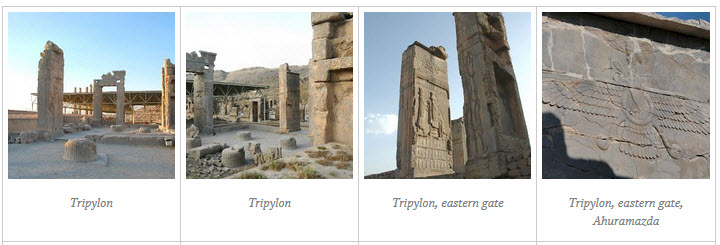 |
Tripylon
Situated slightly to the south of the east staircase of the Apadana, this small, but very elegant palace had an admirable location in the very center of Persepolis and was conveniently linked to most structures of the complex by an elaborate system of vestibules and passageways. The purpose of this building is unknown, but most experts agree that it was probably used as a council hall for meetings between the king and his high officials. The palace consists of a square hall and three imposing stone doorways, hence its name Tripylon, "the Palace of Three Portals”.
The main entrance to the | palace was on the east, and here the king entered the meeting. Two other doorways were incised symmetrically in the north and south walls. The east portal led to an elongated hall with two small chambers flanking it on either side. This section is entirely destroyed, but it is believed to have had a stairway with ten steps, linking the north chamber with a larger staircase of twenty-eight steps. This staircase led to a service room of the Harem and then, through the east door of that room, to the south vestibule of the Hall of a Hundred Columns. The north portal of the Tripylon opened onto a portico supported by two columns linked by a double-flight staircase to the east court of the Apadana. A side vestibule in the west wall of the portico connected it to the south rooms of the Apadana and its central hall. The south portal of the Tripylon led to a small south courtyard, which was in turn linked to the east courtyard of the Hadish and other private palaces. Thus, the Tripylon may have functioned as the main communication link between Persepolis's north area of public buildings, and that portion of the complex which was occupied by the kings' residential palaces.
North staircase:
 |
Modern visitors usually enter the Tripylon from its north side, by a small, but very handsome staircase with crenellated parapets. The staircase has two flights of twenty steps, leading in opposite directions from the bottom landing to a small platform. About halfway up, the flights make a ninety-degree turn and ascend two more steps to reach a second landing; there they twist another ninety degrees, and after eight steps come together at the top landing. The facades of the staircase are decorated with bas-reliefs, showing the procession of Persian and Median noblemen. The central front panel shows the usual arrangement of soldiers, with figures of two sphinxes above them. Pictures of the lion and the bull are portrayed in the conflict in the corner angles, and rows of date palms complete the scene.
The inner side of the staircase portrays the rows of dignitaries, the Medes on one side and the Persians on the other. The Achaemenid artists went to great pains to emphasize the informality and relaxed attitude of these people. Some figures walk intently; others turn around to look at those behind them or hold out a helping hand; still, others steady themselves by resting hands on their shoulders ahead. Some are talking, and some are sniffing flowers, and everyone seems to be having a good time. What is clear is that these men are of equally high rank, as demonstrated by the ornaments they wear, and by the fact that their heads are shown at the same level. Two Persian masters of ceremony, holding long staffs of office, wait for the procession to begin at the foot of the stairs. On the edge of the first landing of the western flight of stairs, one figure is shown wearing a distilled crown; this man may be one of the kings subject to the Achaemenid King of Kings.
North portico:
The carved panel behind the stairs (on the short, enclosing north wall of the portico) shows a group of forty Persian guards, the first twenty being armed with spears and shields, and the rest with spears only. A stone bench abutting the walls of the portico was probably intended as a restful seat for the elderly counselors. The portico had two stone columns, of which only one base remains. A part of the capital of one of the columns has now been set upon this column base.
An impressive doorway of bluish stone links the north portico to the central hall. On both sides of the doorjamb, a similar relief is carved. It portrays the king leaving the hall and followed by two attendants. The king is depicted as very tall in comparison to his servants. He wears Persian clothes, formerly polychromed, and a tiara, formerly adorned with golden plates - which, not surprisingly, are long since gone. He holds a long mace in one hand, and in the other, a lotus bud. Two attendants follow him; one holds a sunshade over the king's head, and the other carries a towel and a flywhisk. Floating above the group is part with a ring in one hand and making a sign of blessing with the other. In Iranian iconography, this ring can be interpreted as representing a commitment between God and the king, who is consecrated in his authority. In accordance with ancient Near Eastern tradition, the king was for all practical purposes the equivalent of divinity itself. By constantly emphasizing the royal-divine bond, the Achaemenid kings might have sought not only to immortalize themselves but to reinforce and legitimize the position of those who were to follow them.
Central hall:
 |
| Tripylon, lamassu National Museum Tehran |
The central hall is a square with each side measuring 15.5 m. It was supported by four columns with capitals shaped like human-headed bulls. The original magnificence of this building, like that of many others, can hardly be imagined even from the impressive portions still standing, for the great wooden doors were covered by delicately patterned gold plates, while brightly colored glazed and terracotta tiles, and paintings on plaster decorated the upper walls. Traces of color have also been found on some column bases and the basreliefs of the staircases. In the center of the | hall (which is also the very center of the entire Persepolis platform) lies a flat, square stone. Its purpose is unclear, but many concur that it was used in some way for astronomical purposes, or could have been helpful in fixing the layout of the entire complex East doorway:
The monarch perhaps carried on a portable throne, entered the central hall through the east door. On both sides of the doorjamb he is portrayed sitting on a finely decorated, tall-backed chair without armrests, and with his feet resting on a low footstool. He holds a long scepter in his right hand and a lotus bud in his left. Behind him stands a crown prince, whose presence is rare in Achaemenid carvings. The crown prince is shown in only one other spot in Persepolis: on the orthostats that were transferred to the Treasury from the Apadana stairs. Both figures are sheltered by a baldachin, decorated with elaborately chiseled bands of rosettes, tassels, and representations of marching lions. Hovering in the center of the canopy is a winged ring of farrk. The platform holding the king and the crown prince is supported by twenty-eight deputies from the subject nations; the deputies are arranged in three registers.
South portico and staircase:
The south doorway, of the same design as the palace's north gate, led to a south portico and a small forecourt. Of this doorway, only one jamb has survived. The portico was supported by two columns and surrounded by a stone bench. The south side of the courtyard opened onto a lane that led to the private palaces, but the east and west sides were enclosed by two short porticos. Each of the porticos featured two columns with capitals shaped like double-headed lions. The south portico of the Tripylon was linked to the courtyard by a double-winged staircase, which was dismantled and brought to the National Museum in Tehran. The bas-reliefs on its exterior surface closely repeat the motifs used in the north staircase, but those on the inside are completely different. They show servants dressed in Persian and Median clothes, completed by cloth headdresses, covering their mouths and chins. The servants carry a lamb, a kid, a wineskin, bowls for drinks, and covered containers. They are on their way to the private palaces, perhaps bringing items for a feast. scholars determine its ancient function. Because the structure stood at the highest level of the platform, some have surmised that it could have been a fire temple. Further research, however, has shown that the building had a staircase, which was later removed to the Tachara courtyard. Its bas-reliefs portrayed royal guards and servants - subjects too “secular” to be engraved on sanctuary walls. With this in mind, some scholars have suggested that the building was a private palace, dating perhaps from the reign of Artaxerxes III.
- Details
- Category: Museums of Shiraz